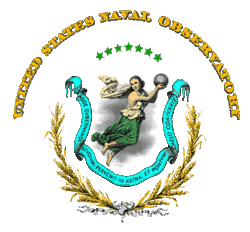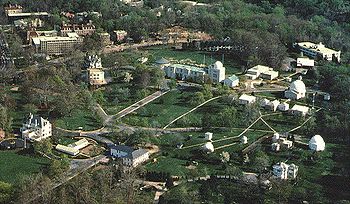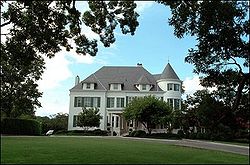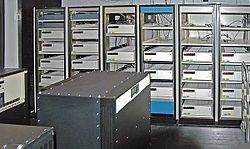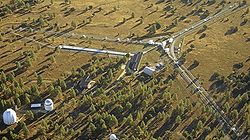- United States Naval Observatory
-
The United States Naval Observatory (USNO) is one of the oldest scientific agencies in the United States, with a primary mission[1] to produce Positioning, Navigation, and Timing (PNT)[2] for the U.S. Navy and the U.S. Department of Defense. Located in Northwest Washington, D.C., it is one of the pre-1900 astronomical observatories located in an urban area; at the time of its construction, it was far from the light pollution thrown off by the (then-smaller) city center. Today, the observatory's primary observational work is done at the U.S. Navy's higher elevation United States Naval Observatory, Flagstaff Station (NOFS) near Flagstaff, Arizona. USNO also has an "Alternate Master Clock" site in Colorado Springs, CO[3] which, with the "Master Clock",[4] provides precise time to the GPS satellite constellation run by the U.S. Air Force; and it performs radio VLBI-based positions of quasars with numerous global collaborators, in order to produce Earth Orientation parameters. Aside from its scientific mission, since 1974, the Observatory is the official residence of the Vice President of the United States.
Contents
History
Established by the order of the Secretary of the Navy John Branch on 6 December 1830 as the Depot of Charts and Instruments,[5] the Observatory rose from humble beginnings. Placed under the command of Lieutenant Louis M. Goldsborough, with an annual budget of $330, its primary function was the restoration, repair, and rating of navigational instruments. It was made into a national observatory in 1842 via a federal law and a Congressional appropriation of $25,000. Lieutenant James Melville Gilliss was put in charge of "obtaining the instruments needed and books."[6]
The observatory's primary mission was to care for the United States Navy's marine chronometers, charts, and other navigational equipment. It calibrated ships' chronometers by timing the transit of stars across the meridian. Initially located downtown at 38°53′42″N 77°03′05″W / 38.89510°N 77.05145°W in Foggy Bottom (near the Lincoln Memorial), the observatory moved in 1893 to its present location[7] on a 2000-foot circle of land atop Observatory Hill overlooking Massachusetts Avenue.
The first superintendent was Navy Commander Matthew Fontaine Maury. Maury had the world's first vulcanized time ball, created to his specifications by Charles Goodyear for the U.S. Observatory. It was the first time ball in the United States, being placed into service in 1845, and the 12th in the world. Maury kept accurate time by the stars and planets. The time ball was dropped every day except Sunday precisely at the astronomically defined moment of Mean Solar Noon, enabling all ships and civilians to know the exact time. By the end of the American Civil War, the Observatory's clocks were linked via telegraph to ring the alarm bells in all of the Washington, D.C. firehouses three times a day, and by the early 1870s the Observatory's daily noon time signal was being distributed nationwide via the Western Union Telegraph Company. Time was also "sold" to the railroads and was used in conjunction with railroad chronometers to schedule American rail transport. Early in the 20th century, the Arlington Time Signal broadcast this service to wireless receivers.
The names "National Observatory" and "Naval Observatory" were both used for 10 years, until a ruling was passed to use only the term "Naval Observatory".[8]
In 1849 the Nautical Almanac Office (NAO) was established in Cambridge, Massachusetts as a separate organisation. It was moved to Washington, D. C. in 1866, colocating with the U. S. Naval Observatory in 1893. On September 20, 1894, the NAO became a "branch" of USNO, however it remained autonomous for several years after this.[9]
President John Quincy Adams, who in 1825 signed the bill for the creation of a national observatory just before leaving presidential office, had intended for it to be called the National Observatory. He spent many nights at the observatory with Maury, watching and charting the stars, which had always been one of Adams' avocations.
In November 1913 the Paris Observatory, using the Eiffel Tower as an antenna, exchanged sustained wireless (radio) signals with the United States Naval Observatory, using an antenna in Arlington, Virginia to determine the exact difference of longitude between the two institutions.[10]
In 1934, the last large telescope to be installed at USNO saw "first light". This 40-inch aperture instrument[11] was also the second (and final) telescope made by famed optician, George Ritchey. The Ritchey-Chrétien telescope design has since become the defacto optical design for nearly all major telescopes, including the famed Keck telescopes and the spaceborne Hubble Telescope. Unfortunately, light pollution forced USNO to think of other more viable locations to continue work, and so began a search. The final dark sky site chosen was Flagstaff, Arizona, and so the 40-inch telescope was moved to that location, beginning operations at the new Navy command, now called the Naval Observatory Flagstaff Station (NOFS). Those operations commenced in 1955,[12] and within a decade, the Navy's largest telescope, the 61-inch "Kaj Strand Astrometric Reflector" was built, seeing light at NOFS in 1964.[13]
The modern United States Naval Observatory continues to be a major authority in the areas of precise time and time interval, Earth orientation, astrometry and celestial observation. In collaboration with many national and international scientific establishments, it determines the timing and astronomical data required for accurate navigation, astrometry, and fundamental astronomy and calculation methods—and distributes this information (such as astronomical catalogs)[14] in the Astronomical Almanac, the Nautical Almanac, and on-line.[15]
Perhaps it is best known to the general public for its highly accurate ensemble of atomic clocks and its year 2000 Timeball replacement. The site also houses the largest astronomy library in the United States (and the largest astrophysical periodicals collection in the world).[16] The library includes a large collection of rare, often famous, physics and astronomy books from across the past millennium.
USNO continues to maintain its dark-sky observatory, NOFS, near Flagstaff, Arizona, which also now oversees the Navy Prototype Optical Interferometer.[17] NOFS opens to the public one weekend annually, in the autumn.[18] The Alternate Master Clock, mentioned above, also continues to operate at Schriever AFB in Colorado.
Departments
In 1990, the Orbital Mechanics Department and Astronomical Applications Department were established, and Nautical Almanac Office became a division of the Astronomical Applications Department.[9][19] The Orbital Mechanics Department operated under P.K. Seidelmann until 1994 when the department was abolished, and its functions were moved to a group within the Astronomical Applications Department.[9]
Official Residence of the Vice President of the United States
Since 1974, and separated from auspices of the Naval Observatory, Number One Observatory Circle, a house situated in the grounds of the observatory (formerly the residence of its superintendent, and later the home of the Chief of Naval Operations), has been the official residence of the Vice President of the United States.
According to a May 15, 2009 blog posting by Newsweek's Eleanor Clift,[20] Vice President Joe Biden recently revealed the existence of what Clift described as a bunker-like room in the residence. The bunker is the secure, undisclosed location where former Vice President Dick Cheney remained under protection in secret after the 9/11 attacks: according to Clift's report, entitled "Shining Light on Cheney's Hideaway"
Biden said a young naval officer giving him a tour of the residence showed him the hideaway, which is behind a massive steel door secured by an elaborate lock with a narrow connecting hallway lined with shelves filled with communications equipment.
Biden's press office subsequently issued a statement denying the bunker report, suggesting that Biden had instead been describing "an upstairs workspace".[21]
Time service
The U.S. Naval Observatory operates two Master Clock facilities. The primary facility, in Washington, D.C. maintains 57 HP/Agilent/Symmetricom 5071A-001 high performance cesium atomic clocks and 24 hydrogen masers. The alternate master clock, at Schriever Air Force Base, maintains 12 cesium clocks and 3 masers.[22] The observatory also operates two rubidium atomic fountain clocks, which have a stability reaching 7×10−16.[23] The observatory intends to build several more of this type for use at its two facilities.[22]
The U.S. Naval Observatory provides public time service via 26[22] NTP servers on the public Internet,[24] and via telephone voice announcements:[25]
- +1 202 762-1401 (Washington, D.C.)
- +1 202 762-1069
- +1 719 567-6742 (Colorado Springs)
The voice of actor Fred Covington (1928–1993) has been announcing the USNO time since 1978.[26]
The voice announcements provide local and universal time every 15 seconds over a background of once-per-second ticks, with the ticks lengthened to prominent beep twice per 15 seconds after the preceding voice announcement.
The voice announcements always begin with the local time. When calling Washington, silence (only second ticks) may be heard for a few seconds before the next scheduled local time announcement. When calling Colorado, the local time announcement begins at the next 5 second interval, which means that the seconds portion of the times announced depends on the time of the call, and that there is a 1 in 3 chance, as shown in the table, of there being no beep at the top of each minute, which is what most watches and clocks require to synchronize.
USNO telephone time service example, beginning 23:33:00 UTC Seconds Washington Colorado (1 of 3 possibilities) :00–:04 Universal time 23 hours, 33 minutes, 5 seconds. Mountain Daylight Time 17 hours, 33 minutes, 5 seconds. :05–:09 U.S. Naval Observatory Master Clock. At the tone,
Eastern Daylight Time 19 hours, 33 minutes, 15 secondsUniversal time 23 hours, 33 minutes, 10 seconds. :10–:14 U.S. Naval Observatory Master Clock. At the tone,
Mountain Daylight Time 17 hours, 33 minutes, 20 seconds.:15–:19 Universal time 23 hours, 33 minutes, 20 seconds. :20–:24 U.S. Naval Observatory Master Clock. At the tone,
Eastern Daylight Time 19 hours, 33 minutes, 30 seconds.Universal time 23 hours, 33 minutes, 25 seconds. :25–:29 U.S. Naval Observatory Master Clock. At the tone,
Mountain Daylight Time 17 hours, 33 minutes, 35 seconds.:30–:34 Universal time 23 hours, 33 minutes, 35 seconds. :35–:39 U.S. Naval Observatory Master Clock. At the tone,
Eastern Daylight Time 19 hours, 33 minutes, 45 seconds.Universal time 23 hours, 33 minutes, 40 seconds. :40–:44 U.S. Naval Observatory Master Clock. At the tone,
Mountain Daylight Time 17 hours, 33 minutes, 50 seconds.:45–:49 Universal time 23 hours, 33 minutes, 50 seconds. :50–:54 U.S. Naval Observatory Master Clock. At the tone,
Eastern Daylight Time 19 hours, 34 minutes, exactly.Universal time 23 hours, 33 minutes, 55 seconds. :55–:59 U.S. Naval Observatory Master Clock. At the tone, The USNO also operates a modem time service,[27] and provides time to the Global Positioning System.
Publications
- Astronomical Observations made at the U.S. Naval Observatory (USNOA) (v.1-6: 1846-1867)
- Astronomical and Meteorological Observations made at the U.S. Naval Observatory (USNOM) (v.1-22: 1862-1880)
- Observations made at the U.S. Naval Observatory (USNOO) (v.1-7: 1887-1893)
- Publications of the U.S. Naval Observatory, Second Series (PUSNO) (v.1-16: 1900-1949)
- U.S. Naval Observatory Circulars[28]
- The Astronomical Almanac
- The Nautical Almanac
- The Air Almanac
- Astronomical Phenomena
See also
- List of observatories
- Navy Prototype Optical Interferometer
- Rear Admiral Samuel P. Carter
- United States Naval Observatory Flagstaff Station
Notes
- ^ USNO Master Clock Time Javascript must be Enabled. "The USNO's Mission — Naval Oceanography Portal". Usno.navy.mil. http://www.usno.navy.mil/USNO/about-us/the-usno-mission/. Retrieved 2011-07-27.
- ^ "National Executive Committee for Space-Based Positioning, Navigation, and Timing". Pnt.gov. 2011-06-17. http://pnt.gov/101. Retrieved 2011-07-27.
- ^ "USNO Alternate Master Clock — Naval Oceanography Portal". Usno.navy.mil. 1996-06-15. http://www.usno.navy.mil/USNO/time/master-clock/u.s.-naval-observatory-alternate-master-clock/. Retrieved 2011-07-27.
- ^ "USNO Master Clock — Naval Oceanography Portal". Usno.navy.mil. http://www.usno.navy.mil/USNO/time/master-clock/. Retrieved 2011-07-27.
- ^ Matchette, R. B.; et al. (1995). Guide to Federal Records in the National Archives of the United States.. Washington, DC: National Archives and Records Administration. http://www.archives.gov/research/guide-fed-records/groups/078.html.
- ^ "U.S. Navy's James Melville Gilliss Library". http://www.usno.navy.mil/USNO/library/library-home/.
- ^ "The new U.S. Naval Observatory, Washington". Monthly Notices of the Royal Astronomical Society 54: 261. 1894. Bibcode 1894MNRAS..54..261..
- ^ Frances Leigh Williams (1963). "VIII. Scientific Opportunity at Last". Matthew Fontaine Maury: Scientist of the Sea. Rutgers University Press, New Brunswick. p. 164. "These different names for the Observatory and the term 'Hydrographic Office' were used interchangeably until December, 1854, when the Secretary of the Navy officially ruled that the proper designation was 'The United States Naval Observatory and Hydrographical office.'"
- ^ a b c Steven J. Dick (2003). Sky and ocean joined: the U.S. Naval Observatory, 1830-2000. Cambridge University Press. pp. 547–8,574. ISBN 0521815991.
- ^ "Paris Time By Wireless," New York Times, November 22, 1913, pg 1.
- ^ "U.S. Naval Observatory Flagstaff - 1.0-m Ritchey-Chretien Reflector". Nofs.navy.mil. 1998-01-25. http://www.nofs.navy.mil/about_NOFS/telescopes/rc.html. Retrieved 2011-07-27.
- ^ "USNO Flagstaff Station - History". Nofs.navy.mil. http://www.nofs.navy.mil/about_NOFS/hist.html. Retrieved 2011-07-27.
- ^ "U.S. Naval Observatory Flagstaff - 1.55-m Astrometric Reflector". Nofs.navy.mil. 2001-05-24. http://www.nofs.navy.mil/about_NOFS/telescopes/ksar.html. Retrieved 2011-07-27.
- ^ USNO Master Clock Time Javascript must be Enabled. "Catalog Information — Naval Oceanography Portal". Usno.navy.mil. http://www.usno.navy.mil/USNO/astrometry/information/catalog-info. Retrieved 2011-07-27.
- ^ USNO Master Clock Time Javascript must be Enabled. "Interactive Catalog and Image Search — Naval Oceanography Portal". Usno.navy.mil. http://www.usno.navy.mil/USNO/astrometry/optical-IR-prod/icas/fchpix. Retrieved 2011-07-27.
- ^ USNO Master Clock Time Javascript must be Enabled. "The James Melville Gilliss Library — Naval Oceanography Portal". Usno.navy.mil. http://www.usno.navy.mil/USNO/library. Retrieved 2011-07-27.
- ^ [1][dead link]
- ^ "Tour and Visiting Information for USNO Flagstaff Station". Naval Meteorology and Oceanography Command. 2009-05-17. http://www.usno.navy.mil/USNO/tours-events/tour-information/visit-usnofs. Retrieved 2009-05-17.
- ^ "Nautical Almanac Office 1975-1996". Aas.org. http://aas.org/archives/BAAS/v29n5/aas191/abs/S001005.html. Retrieved 2011-07-27.
- ^ by Daniel StoneMay 16, 2009 (2009-05-16). "Shining Light On Cheney's Hideaway". Blog.newsweek.com. http://blog.newsweek.com/blogs/thegaggle/archive/2009/05/15/shining-light-on-cheney-s-hideaway.aspx. Retrieved 2011-07-27.
- ^ "Biden Reveals Location of Secret VP Bunker". FOX News. 2009-05-17. http://www.foxnews.com/politics/2009/05/17/oops-biden-reveals-location-secret-vp-bunker/. Retrieved 2009-05-17.
- ^ a b c Matsakis, Demetrios (2010-09-20), "Report from the U.S. Naval Observatory", Civil GPS Service Interface Committee, http://www.navcen.uscg.gov/pdf/cgsicMeetings/50/%5B15%5DUSNOreport_matsakis_sep2010.pdf, retrieved 2010-10-31
- ^ "Initial Evaluation of the USNO Rubidium Fountain (PDF)". http://ad.usno.navy.mil/edboard/060127.pdf. Retrieved 2010-11-17.
- ^ "Usno Network Time Servers". Tycho.usno.navy.mil. http://tycho.usno.navy.mil/ntp.html. Retrieved 2011-07-27.
- ^ "Telephone Time — Naval Oceanography Portal". Usno.navy.mil. http://www.usno.navy.mil/USNO/time/telephone-time. Retrieved 2011-07-27.
- ^ "Biography for Fred Covington". Internet Movie Database. http://www.imdb.com/name/nm0184488/bio. Retrieved 2008-06-30.
- ^ "USNO Master Clock via Modem". Tycho.usno.navy.mil. http://tycho.usno.navy.mil/modem_time.html. Retrieved 2011-07-27.
- ^ USNO Master Clock Time Javascript must be Enabled. "U.S. Naval Observatory Special Publications — Naval Oceanography Portal". Usno.navy.mil. http://www.usno.navy.mil/USNO/astronomical-applications/publications/usno-special-pubs. Retrieved 2011-07-27.
Further reading
- Sky and Ocean Joined – The U.S. Naval Observatory 1830-2000 by Steven J. Dick (2003) ISBN 0-521-81599-1
- "The United States Naval Observatory". Harper's magazine 48: 531–539. 1874. http://books.google.com/books?id=jYICAAAAIAAJ&pg=PA531.
External links
{{ cite old archiveurl=http://web.archive.org/web/20060321125122/http://www.cstone.net/~wmm/mfm-1847/index.html
| archivedate = 2006-03-21 }}Coordinates: 38°55′17″N 77°04′01″W / 38.921473°N 77.066946°W
Categories:- United States Navy facilities
- Buildings of the United States government in Washington, D.C.
- Vice Presidency of the United States
- Landmarks in Washington, D.C.
- Astronomical observatories in Washington, D.C.
Wikimedia Foundation. 2010.

